"She measures time not by days, months or years, but by the empires she has seen rise and crumble to ruin. She is a type of immortality. Damascus has seen all that ever occurred on earth and still she lives. She has looked upon the dry bones of a thousand empires, and will see the tombs of a thousand more before she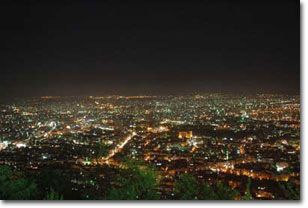 dies." [Mark Twain Innocents Abroad] dies." [Mark Twain Innocents Abroad]The city could be viewed from Mount Kassioun which dominates the city. The mountain itself has attracted several legends including the belief that here Abraham had the unity of God revealed to him. No large scale systematic excavations have been possible in a city so continuously and densely inhabited as in Damascus. The settlement of this oasis clearly goes back to the earliest phase of post-nomadic economic development - the 4th millennium or before - making Damascus one of the oldest continuously inhabited urban centers in the world. The first historical record of "Dimashqa" (Damascus) is in the Mari tablets (c2500 BC) and a little later as "Dimaski" in the Ebla archives. Amorite settlement began around the beginning of the second millennium BC. Later in the millennium it became into the Egyptian sphere of influence and is mentioned in the Amarna archives (18th dynasty - 14th century BC). After the invasions of Sea Peoples 1200 BC, it recovered under the Arameans. They established here their principality of Aram-Damascus which took a leading role in the expansion of the biblical kingdoms of Israel and Judea. The city fell to Assyrians in 732 BC. In 572, the Neo-Babylonian (or Chaldean) king, Nebuchadnezzar, conquered Syria and Palestine but the Chaldean dynasty itself was overwhelmed shortly after in 539 when the Persian King, Cyrus, took the whole region in the course of his sweep towards the Aegean. Alexander's great campaign brought Damascus under Greek control in 332 following the battle of Issues. The subsequent rule by Greek brought town-planning to Damascus (Straight Street). Roman rule lasted 700 years in all forms. From 37 BC to AD 54, the Romans accepted continued Nabataean control of Damascus. It remained a city-state and was under improvements as well as other cities under Roman rule. The town plan was improved further, an aqueduct system brought the waters of the River Barada to homes and baths and the city was walled and furnished with nine gates; seven of them are standing still today. Damascus, which housed an important Jewish colony, was associated with the earliest phase of the spread of Christianity and the mission of St Paul. Hadrian gave it the rank of metropolis (117 AD), later was raised to Colonia under Alexander Severus (222). In the Umayyad period of Islamic rule, Khalid Bin al-Walid took Damascus from the Romans after 6 months siege. It was made the capital of the Umayyad Empire under the 5th Caliph, a;-Moawiya, in 661, thus ending a thousand years of western supremacy. This Empire had provided Damascus with the most lasting and impressive monument to its fame, the Great Mosque of the Umayyads, built by the Caliph al-Walid after 706 on the site of the Cathedral of St John the Baptist (earlier Temple of Hadad). Many dynasties were competing for control of Syria, Tulunid, Ikhshidid, Fatimid, Hamdanid and Seljuq dynasties from their power bases in Cairo and Mosul. During these centuries of struggle, Damascus was walled for protection of communities separated as quarters. The Muslim resistance to the Crusades began the reversal of this decline. It brought a concentration on Damascus as a bastion of the Muslim cause and thus of Sunny orthodoxy. To this era belongs the reconstruction of the defenses of the city including the major gateways, the Citadel and its surrounding walls. Damascus was taken by Conrad, king of the Germans, in the second Crusade in 1148. Under the Zengids, Nūr al Din took the city more by charm than by arms in 1154. During his reign, but particularly under his successor, Saladin 1176 - 93, Damascus again became a political center of note and its economy recovered much of its vigor. This was the great age of the Madrasa, the number more than quadrupling in the 13th century in order to reinforce Sunny orthodoxy. After the Mamelukes, the Ottoman Turks conquered Syria and incorporated it into their Empire. This is the era that most of the wealthy families of Ottomans have built great and fancy houses such as al Azem Palace that belongs to Assaad Pasha al Azem, the Governor of Damascus (18th century). The 19th century was more troubled with local resentment against the Ottomans rising. During the French Mandate, the center of gravity of Damascus was about to move to the newly-built Merje Square. Finally, Syria was liberated and got to be the "Syrian Arab Republic" in 1946. The population was still about 52,000 by the 16th century, and grew to become 90,000 by the end of the 18th century, expanding only slowly for the first half of the 19th century, to become over 2.5 million by the end of 1990s. Damascus - Umayyad Mosque: Lying at the east end of Suq al Hamidiyeh, it is a place of magnificent beauty. This site has been marked by sacred enclosures as far back as the second millennium BC. This cult center was first used as a temple (9th century BC) dedicated to the worship of Hadad, who is the Aramean deity representing sun and thunder. Later on, in the 1st century AD, it was taken by the Romans to make it larger Temple of God of the Gods, Jupiter. 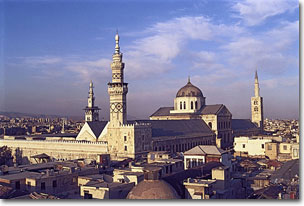 When the Roman capital moved from Rome to Constantinople in 330, Christianity began to spread in the empire and was soon considered the official religion. It was then that the Emperor Theodosius (ruled 193 - 211) abolished pagan worship and made it the cathedral of the city, thus it was dedicated to John the Baptist. With the taking of Damascus by the Arabs in 636, Christians were generally allowed to continue to use their churches and Muslims were settled in new areas of the city. During the first 70 years, the Muslims had built a mud brick structure against the southern wall so that they could pray. Afterwards, Christians became few and Muslims were increasing, so it was changed into a mosque under the rule of the Caliph al-Walid (ruled 705 - 715). The renovation work was done by Architects from Constantinople, Egypt, and Damascus itself. It now holds the Shrine of John the Baptist's head, and there are many rumors to explain how it came to be here. One is that Herod sent it to Damascus so that the Romans could be sure of his execution; while another is that when the Arabs took over the church, John the Baptist's blood bubbled and when the church was being demolished his head was found underneath it with skin and hair. The plan of the mosque is quite simple; there is a magnificent courtyard which is heavily decorated by mosaics. In the middle of the courtyard are the Dome of the hours, the ablutions fountain and the beautifully decorated Dome of the treasure. This mosque is one of the few mosques that has three minarets, Minaret of the Bride (9th and 12th centuries), Minaret of Qayetbey (15th century), and the Minaret of Issa (Jesus) (13th century). Given its setting on flat ground, hemmed in by cluttered urban surrounds, the fortifications never presented the same forbidding front. This citadel stands at the northwest corner of the Old City. It is much smaller than that of Aleppo, and is the only citadel in Syria that is on the same level as the rest of the city. The Roman cast rum or camp was here. Still, there's no firm evidence it was used 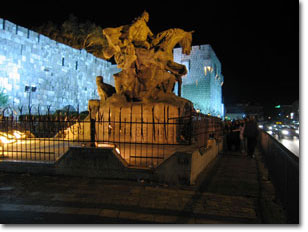 as military base in Roman times. Most of the construction is from the Ayyūbid and Mameluke periods but heavy use since then has not been kind to the fabric. The Sultan al Adel used this fortification to preserve Damascus (1207) against the Crusaders and Mongols in the 13th century. Then Damascus had become the key center of Arab resistance to the Crusader presence, a role built up particularly under the leadership of Saladin (1176 - 93). as military base in Roman times. Most of the construction is from the Ayyūbid and Mameluke periods but heavy use since then has not been kind to the fabric. The Sultan al Adel used this fortification to preserve Damascus (1207) against the Crusaders and Mongols in the 13th century. Then Damascus had become the key center of Arab resistance to the Crusader presence, a role built up particularly under the leadership of Saladin (1176 - 93).In 1260, however, it was destroyed by the first Mongol invasion. It was rebuilt by the Mameluke Sultan Baybars, who made sure that the original 16 towers and walls were rebuilt. However, it was to be heavily knocked down by the second Mongol invasion in 1400 by Timurlenk (Tamerlane). The Ottomans did not really pay much attention to it and it was only slightly repaired, though they used it as military base. The citadel was only abandoned as a prison in 1985. At the present it's under heavy reconstructions and excavation work, which will hopefully uncover its mysterious history. Damascus - Suqs: Suq Al Hamidiyeh: Most of the suq is arched over with high iron ribs with corrugated metal. This bazaar has been rebuilt several times, most recently in the 13th century. It is built on the site of an ancient Roman fortress. Some of these remains can still be seen as you walk through the suq. It has an entrance to one of the most remarkable Islamic institutions in Damascus, the Maristan Nūr al-Din (Hospital of Nūr al-Din). The Hamidiyeh is a suq for general goods where a lot of souvenirs can be bought. Women's clothing (gallabiyas), gold lame toreador pants, nargilehs (hubble-bubble pipes), jewelry, chessboards and inlaid mosaic boxes are the most popular among tourists. It's still alive maintaining its purpose and continuing to be a great place for souvenir shopping. Suq Midhat Pasha: This suq (known as Suq al Taweel - in Roman, Via Recta) was the main link between east and west Damascus. It is parallel to Suq al-Hamidiyeh and runs from Bab Sharki (Eastern Gate) to Bab al-Jabieh (Gate of the Water Trough). This is where the Roman gate of Jupiter once stood. When it was taken over by the Greeks and Alexander the Great, the "old city" was re-designed into the Hippodamian grid pattern, following the ideas of Hippodamus. Under Roman rule, Via Recta was widened and became a colonnaded thoroughfare. These columns are still recognizable at the moment. The Mosque of Hisham (built in 1427), with fine stalactite design, is a bit further on. On the eastern side (Bab Sharki) you will find a Roman arch, which was found by workmen under the French Mandate. The Greek Orthodox Patriarchal church of Virgin Mary is to the north of the arch, this piece of land has been the site of a church going as far back as the Byzantine Empire. This area is the Christian quarter of Damascus, where Christians were allowed to have their churches during the Arab invasions. It was rebuilt in 1878 by the governor of Damascus, Midhat Pasha. The most interesting vestige in this suq is the Arabic style house known as Maktab Anbar. Suq Al Harir (Silk Bazaar) This suq which is situated near the Umayyad mosque was built by Darwish Pasha in 1574. It joins Al Hamidiyeh suq on one side and suq al Khayateen (tailors bazaar) on the other. In this suq is also Madrasa Jaqmaqiye (the Museum of Arabic Epigraphy) built in 1418 - 20 by the Mameluke governor of Damascus, Jaqmaq al Argunsaei, who later became Sultan of Cairo in 1438 - 52. The mausoleum of Nūr al Din Zengi is located between these two Suqs. It was originally housed in Madrasa Aziziye which has disappeared in most, leaving an isolated arch and the burial chamber. Suq Al Bzouriyeh (Spices Bazaar) This is the suq that extends from Suq Midhat Pasha to the Azem palace. It is famous for its small spice and soap shops and for the al- Nūri bath - one of the few baths remaining from the 12th century. There is also Khan Assaad Pasha in the suq. Damascus - Azem Palace and Khans: This old palace goes back to show us the Ottoman residences of Damascus. The Azem Palace was built in the 18th century as a palatial residence for Assaad Pasha al-Azem, Ottoman governor of Damascus for 14 years. It is considered a great example of Damascene houses. 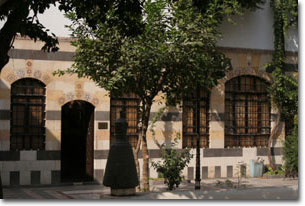 The governor had diverted the waters of Barada to his gardens and summoned most carpenters and masons in Damascus. He also ordered for Roman columns from Bosra to be brought in along with the ancient paving of Banyas. The governor had diverted the waters of Barada to his gardens and summoned most carpenters and masons in Damascus. He also ordered for Roman columns from Bosra to be brought in along with the ancient paving of Banyas.It is divided into separate quarters, one for the kitchens, one for the haremlek (women section), where the governor's family used to live in private, and the third was the selamlek where the governor and other male members of the family would receive guests and conduct their business. Along the south side of the selamlek is a liwan that is very deep into the wall to free it from sunlight during the day. Next to this liwan is a room where the governor would receive his guests, there is a beautiful fountain at the center of its marble floor. The selamlek is, for the most part, used as the Museum of Popular Arts and Tradition. Each room is designed and decorated to show you some of the typical Damascene traditions, including preparation for Hajj and preparation for marriage. It covers the main concentration of traditional khans - the warehouses for the receiving, storing and sending of trade goods and the provision of accommodation to traders. The palace is surrounded with many Khans such as Khan al-Gumruk, Kan al-Haramain, Hammam al-Qishani, Hammam Nūr al-Din, Khan al-Harir and Khan Assaad Pasha. Damascus - National Museum: The National Museum of Damascus is one of the world's great collections of archaeological and historical material. The museum was founded in 1919 and was originally set up, along with the Arab Academy, in the Madrasa al-Adeliye. In 1936, the east wing of the present complex was built. From 1936 to 1952, the building's entrance was embellished by the reconstructions of the gateway from Qasr al-Heir West, an Umayyad desert palace of the eighth century. 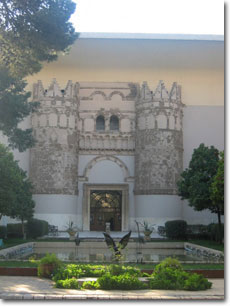 It would be impossible to do it justice in a few words. This museum contains a world-class archaeological and historical collection. The archaeological and historical collections of the Museum are arranged in four Departments: Pre-historic, Ancient Syria, Classical and Arab Islamic Antiquities. Later a Contemporary Art Department was opened. The façade of this museum comprises two semi-cylindrical towers enclosing a rectangular portal, the latter surmounted by a large blank Syrian arch, familiar in the local repertoire for several centuries. It contains rooms devoted to Ras Shamra (Ugarit) with small clay tablets of what is known to be the oldest Alphabet in the world, the Ugaritic Alphabet. It also contains the ivory head of an unknown prince, a collection of cylinder seals, and Mycenaean pottery imported from Greece. Another room is devoted to Mari, the Bronze Age sight on the Euphrates. Here one will find the 3rd Millennium treasure of King Cansud. Further on, you will find a room concentrating on finds from Raqqa, the Abbassid city on the Euphrates. Another hall contains Islamic jewelry, coins and armor, and the final hall in the Byzantine and Islamic Departments is the Damascus Salon, a wood-and-marble paneled room from an 18th-century palace. As for the other two Departments, there are a few rooms exhibiting pottery, sculptures and glassware ranging from the Phoenicians to the classical periods. There are rooms concentrating on the Hauran and Jebel al Arab, where most objects are made of Basalt. Another hall contains classical statues carved in ivory, bronze, and marble, which were found at Palmyra. Further on lies the Palmyra room and adjacent to that is the Dora Europos room. The most popular part of the museum is the 2nd century AD Synagogue that has been reconstructed. Its walls are covered with Talmudic injunctions and paintings of human figures that are in scenes from the Scriptures. Damascus - The Tekkiye Mosque Complex: East of the National Museum, and just over a kilometer west of the Old City lies the Tekkiye mosque complex. The complex was intended to service the great annual pilgrimage to Mecca whose custody was one of the most important duties of the Governor of the vilayat (provinces) of Damascus and the income from which was one of the city's major sources of prosperity. The complex was built on the site of Qasr al Ablaq, a Mameluke palace built by Baybars. It was built at the order of Suleiman the Magnificent (the Great Sultan Suleiman I), was planned by the Architect Sinan and was built mostly by Christian masons and architects who had converted to Islam. The complex consists of three main parts: - The mosque itself is the finest Ottoman monument in the city. - The buildings that surround the mosque's courtyard were also built and planned by Sinan. They were built also as accommodation for the Dervishes, who are known for their religious chants and whirling. It was used later as a khan to house pilgrims who were on their way to Mecca. - On the east side is a Koraanic School called the Selimiye Madrasa, which was added under Suleimans successor, Sultan Selim II between 1566 and 1574 (a decade after the Tekkiye and it's not Sinan's work). The prayer room of the Madrasa is still used as a school to teach Koran. The buildings round the school are currently being used by craftsmen, who sell products such as glass, copper, jewelry, inlaid boxes and carpets. East of the Tekkiye complex lies the Military Museum, this houses old weaponry and combat tools. This weaponry ranges from 13th century weapons used against the Crusaders and Mongols to modern Russian weaponry. The Straight Street / Via Recta (modern Suq Bab Touma): Straight street or in Roman, Via Recta, was the main link between east and west Damascus. When it was taken over by the Greeks and Alexander the Great, the "old city" was redesigned into the Hippodamian grid pattern, following the ideas of Hippodamus. This reflected the Greek sense of order. Under Roman rule, Via Recta was widened and became a colonnaded thoroughfare. These columns are still recognizable at the moment. Starting from the western section of this Street you will be passing through 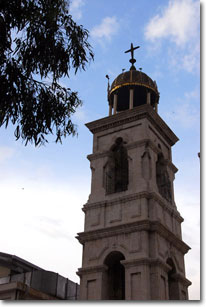 the Arab Gate of the Water Trough, Bab al-Jabiye. This is where the Roman gate of Jupiter once stood. The Mosque of Hisham (built in 1427), with fine stalactite design, is a bit further on. It is believed that the theatre built by Herod the Great in the 1st century BC was in this area. Going further into the covered section of the street you will find two khans (Khan Djaqmaq, and Khan al-Zait), the former is a Mameluke structure built in 1420, the latter was originally a caravanserai for olive oil. the Arab Gate of the Water Trough, Bab al-Jabiye. This is where the Roman gate of Jupiter once stood. The Mosque of Hisham (built in 1427), with fine stalactite design, is a bit further on. It is believed that the theatre built by Herod the Great in the 1st century BC was in this area. Going further into the covered section of the street you will find two khans (Khan Djaqmaq, and Khan al-Zait), the former is a Mameluke structure built in 1420, the latter was originally a caravanserai for olive oil.On the eastern side you will find a Roman arch, which was found by workmen under the French Mandate. It is thought to have been part of a 3rd century AD Tetrapylon at the intersection of the Via Recta. The Greek Orthodox Patriarchal church of Virgin Mary is to the north of the arch, this piece of land has been the site of a church going as far back as the Byzantine Empire. This area is the Christian quarter of Damascus, where Christians were allowed to have their churches during the Arab invasions. To the south is the Jewish quarter (although Christians now mostly inhabit it). Further on lies St. Paul's chapel, which is where St. Paul fled by being dropped in a basket through a window in the wall. The end of Straight Street is where Bab Sharki lies, the Roman gate of the Sun. The House of Hananiya is nearby. Hananiya is the one who restored Paul's sight in Acts 9:17. Old Churches: St. Paul's Church: It commemorates the memory of St. Paul, whose name was Saul of Tarsus, charged by the Romans to persecute the Christians. As he approached the village of Daraya, a burst of blinding light took his sight away, and he heard Jesus Christ ask him "Saul, why do you persecute me? This was a vision of faith. He was taken unconscious to Damascus, attended by Hananiya, Christ's disciple, and became one of the staunchest advocates of Christianity. His Jewish peers decided to kill him, but he hid in a house by the city wall. The church is located at the site of his escape. He traveled to Antioch, Athens, and Rome, after a brief stay in Jerusalem, and continued to teach the gospel until he died. St. Ananias' Church: 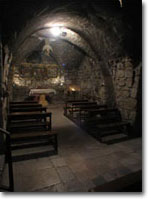 Ananias was a disciple of Jesus, and is traditionally listed as one of the Seventy Disciples whose mission is recorded in Luke 10. He also was the man reported in the Bible to have been sent by God to heal Paul's blindness and join him with the Church. He restored his eye-sight and baptized him. He became the first bishop of Damascus, and was stoned to death in 40. Ananias was a disciple of Jesus, and is traditionally listed as one of the Seventy Disciples whose mission is recorded in Luke 10. He also was the man reported in the Bible to have been sent by God to heal Paul's blindness and join him with the Church. He restored his eye-sight and baptized him. He became the first bishop of Damascus, and was stoned to death in 40.Al Maryamieh; the Greek Orthodox Patriarchate of Antioch and all the East: The seat of the patriarchate was formerly in Antioch, in what is now Turkey. Now it is in Damascus, Syria, located on the "street called Straight." The current patriarch is His Beatitude Patriarch Ignatius IV (Hazim) of Antioch and all the East. |
Sunday, May 22, 2011
Damascus
Subscribe to:
Post Comments (Atom)
No comments:
Post a Comment